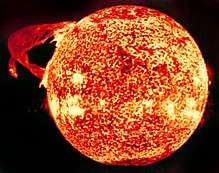Solar Radiation and Climate Experiment
 SORCE in flight | |
| Organization | NASA, LASP at CU-Boulder |
|---|---|
| Contractor | Orbital Sciences Corporation |
| Mission Type | Astrophysics |
| Satellite of | Earth |
| Launch | January 25, 2003 on a Pegasus XL |
| Launch site | Cape Canaveral Air Force Station |
| Mission duration | 6 years |
| Mass | 315 kg (launch), 290 kg (dry) |
| Webpage | http://lasp.colorado.edu/sorce/ |
| Orbital elements | |
| Semi-major axis | 7,002.26 kilometres (4,351.00 mi) |
| Orbital eccentricity | 0.0024 |
| Inclination | 39.99 degrees |
| Orbital Period | 97.19 minutes |
| Apoapsis | 657 kilometres (408 mi) |
| Periapsis | 617 kilometres (383 mi) |
| Right ascension of the ascending node | 135.41 degrees |
| Argument of perigee | 136.06 degrees |
| Instruments | |
| TIM | Total Irradiance Monitor |
| SOLSTICE | Solar Stellar Irradiance Comparison Experiment |
| SIM | Spectral Irradiance Monitor |
| XPS | Extreme ultraviolet Photometer System |
The Solar Radiation and Climate Experiment (SORCE) is a NASA-sponsored satellite mission that measures incoming X-ray, ultraviolet, visible, near-infrared, and total solar radiation.[1] These measurements specifically address long-term climate change, natural variability and enhanced climate prediction, and atmospheric ozone and UV-B radiation. These measurements are critical to studies of the Sun, its effect on our Earth system and its influence on humankind. The SORCE spacecraft launched on January 25, 2003 on a Pegasus XL launch vehicle to provide NASA's Earth Science Enterprise (ESE) with precise measurements of solar radiation.
SORCE measures the Sun's output using radiometers, spectrometers, photodiodes, detectors, and bolometers mounted on a satellite observatory. The SORCE satellite orbits the Earth accumulating solar data. Spectral measurements identify the irradiance of the Sun by characterizing the Sun's energy and emissions in the form of color that can then be translated into quantities and elements of matter. Data obtained by the SORCE experiment can be used to model the Sun's output and to explain and predict the effect of the Sun's radiation on the Earth's atmosphere and climate.
Flying in a 645 km, 40 degree orbit, SORCE is operated by the Laboratory for Atmospheric and Space Physics (LASP) at the University of Colorado at Boulder, Colorado. It will continue the precise measurements of total solar irradiance that began with the ERB instrument in 1979 and has continued to the present with the ACRIM series of measurements. SORCE will also provide the measurements of the solar spectral irradiance from 1 nm to 2000 nm, accounting for 95 % of the spectral contribution to the total solar irradiance. SORCE carries four instruments including the Total Irradiance Monitor (TIM), Solar Stellar Irradiance Comparison Experiment (SOLSTICE), Spectral Irradiance Monitor (SIM), and the XUV Photometer System (XPS).
Objectives
The science objectives of the SORCE mission are:[2]
- to make accurate measurements with high precision of total solar irradiance, connect them to previous TSI measurements, and continue this long-term climate record. Provide TSI with an accuracy of 0.01% (100 parts per million) based on SI units and with a long-term repeatability of 0.001%/yr.
- to make daily measurements of the solar ultraviolet irradiance from 120 to 300 nm, with a spectral resolution of 1 nm. Achieve this spectral irradiance measurement with an accuracy of better than 5%, and with a long-term repeatability of 0.5%/yr. Use the solar/stellar comparison technique to relate the solar irradiance to the ensemble average flux from a number of bright, early-type stars (same stars used by the UARS SOLSTICE program).
- to make the first measurements of the visible and near IR solar irradiance with sufficient precision for future climate studies. Obtain daily measurements of solar spectral irradiance between 0.3 and 2 µm with a spectral resolution of at least 1/30, an accuracy of 0.03%, and a long-term repeatability of better than 0.01%/yr.
- to improve the understanding of how and why solar irradiance varies, estimate past and future solar behavior, and investigate climate responses.
Solar Irradiance Monitor
The Spectral Irradiance Monitor is a spectrometer that provides long-duration solar spectral irradiance measurements in the visible and near infrared (Vis/NIR). The wavelength coverage is primarily from 300 to 2400 nm, with an additional channel to cover the 200-300 nm ultraviolet spectral region to overlap with the SOLSTICE, another instrument on board the SORCE satellite.
See also
References
- ↑ "SORCE". LASP. Retrieved 19 October 2011.
- ↑ "Objectives". Laboratory for Atmospheric and Space Physics. Retrieved: 31 December 2016.

